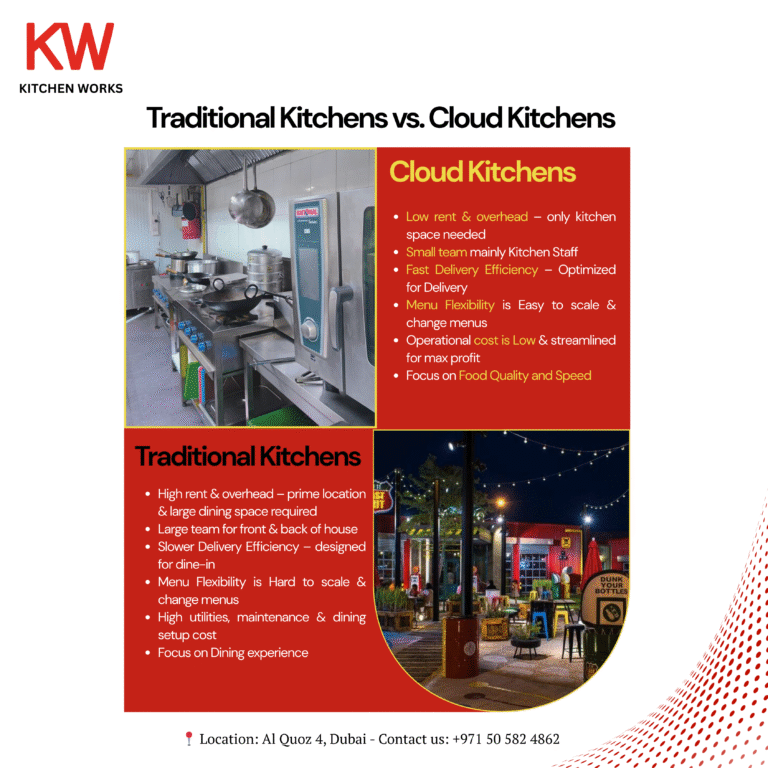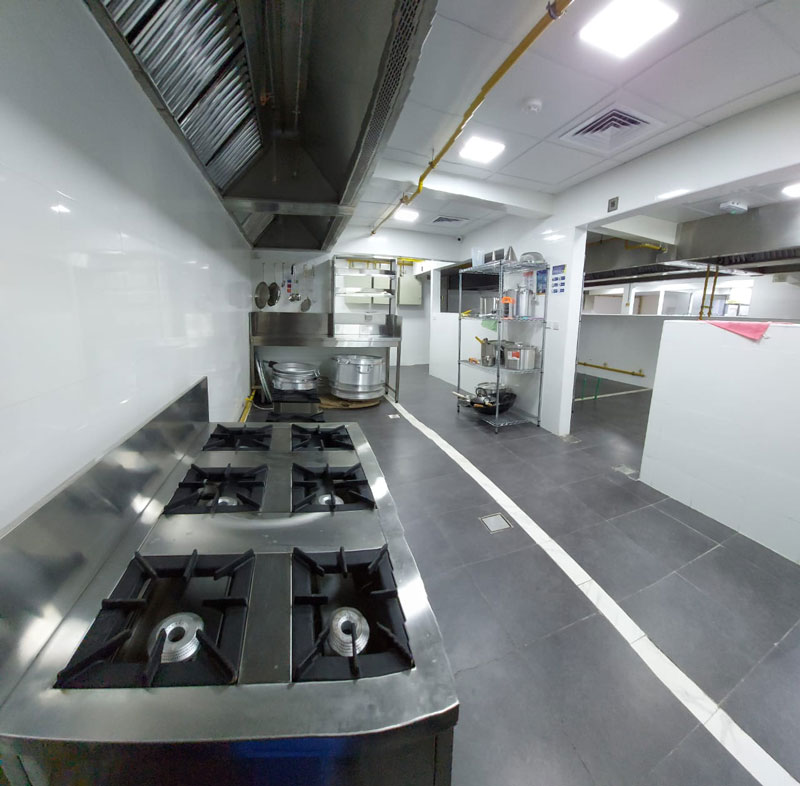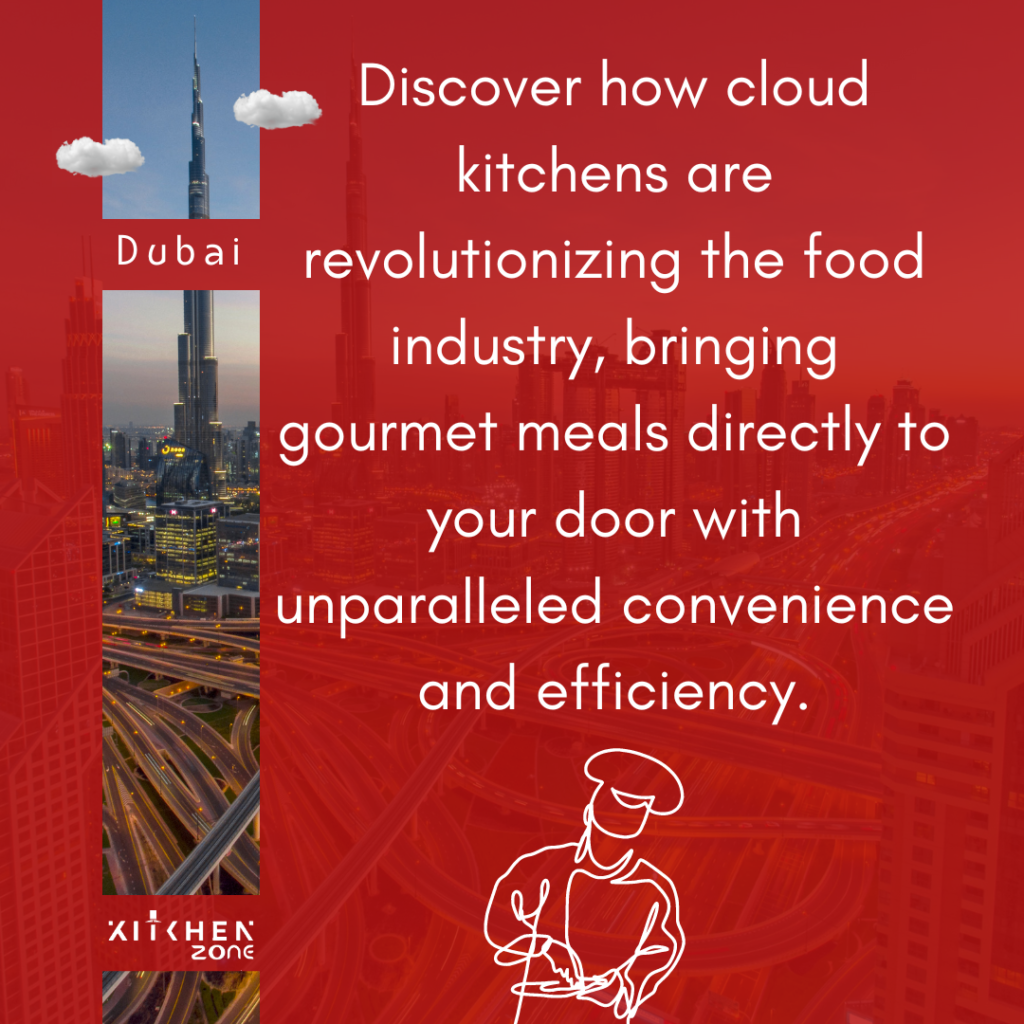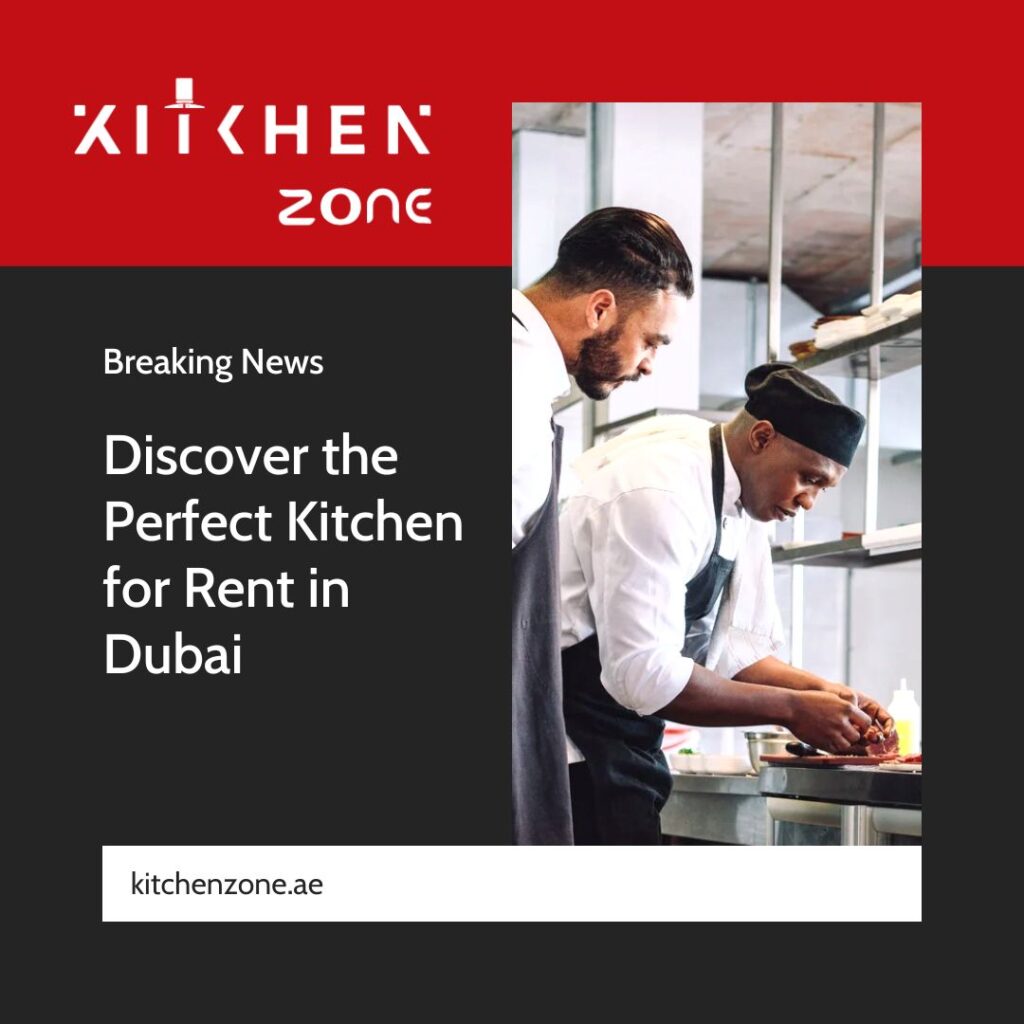Table of Contents
- Introduction
- What Exactly Are Cloud Kitchens?
- Traditional Kitchens: A Quick Overview
- Cloud Kitchens vs Traditional Kitchens: Key Differences
- Why Are Cloud Kitchens Growing So Fast?
- Are Cloud Kitchens Profitable?
- How Do Cloud Kitchens Work?
- Advantages of Cloud Kitchens Over Traditional Kitchens
- How Much Does It Cost to Start a Cloud Kitchen in Dubai?
- Are Cloud Kitchens the Future of Restaurants?
- Cloud Kitchens vs Traditional Kitchens: Which Should You Choose?
- Best Practices for Running a Cloud Kitchen Successfully
- Conclusion
Introduction
The restaurant industry in Dubai is experiencing a revolutionary shift, and the driving force behind this transformation is the rise of Cloud Kitchen. Known as virtual kitchens, dark kitchens, or ghost kitchens, this model is gaining popularity worldwide and is especially thriving in Dubai due to its dynamic food delivery ecosystem.
At Kitchen Works, we specialize in supporting entrepreneurs and established food brands that want to maximize their success with cloud kitchens. In this blog, we’ll provide a detailed comparison between cloud kitchens and traditional kitchens, explore why cloud kitchens are booming in Dubai, highlight their benefits and challenges, and share how Kitchen Works helps businesses succeed. This comprehensive guide is designed to give you valuable insights into the future of dining and help your business make informed decisions.
But what exactly are Cloud Kitchen, and how do they compare to Traditional Kitchen with dine-in spaces? In this article, we’ll break down everything you need to know — from cost savings, scalability, and customer reach, to answering common questions people search for, like:
- What are Cloud Kitchen and how do they work?
- Are Cloud Kitchens better than traditional restaurant?
- What are the benefits and challenges of Cloud Kitchens?
- How much does it cost to set up a Cloud Kitchen in Dubai?
Let’s dive into the world of Cloud Kitchens vs Traditional Kitchens and see which model is better for today’s food entrepreneurs.
What Exactly Are Cloud Kitchen?
A Cloud Kitchen, also known as a ghost kitchen, dark kitchen, or virtual kitchen, is a commercial kitchen designed only for food delivery. Unlike traditional restaurants, there’s no dining area, no waiters, and no fancy décor. Instead, it’s optimized for preparing meals that go directly to customers through apps like Talabat, Zomato, Deliveroo, or Uber Eats.
In simple words: Cloud Kitchens are kitchens without a storefront.
Traditional Kitchens: A Quick Overview
A Traditional Kitchen in the restaurant world refers to a physical space where food is prepared and served to customers on-site. It involves dine-in seating, ambience, interior design, and often relies heavily on walk-in customers in addition to takeout or delivery orders. While this model has worked for decades, it comes with higher operational costs, rent, and staffing needs compared to Cloud Kitchens.
Cloud Kitchen vs Traditional Kitchen: Key Differences
| Aspect | Cloud Kitchens | Traditional Kitchens |
|---|---|---|
| Customer Experience | Delivery-only | Dine-in + Delivery |
| Setup Cost | Low (No seating, décor) | High (Ambience, furniture, staff) |
| Location Flexibility | Can be in low-rent areas | Must be in prime locations |
| Revenue Model | Online orders only | Walk-ins + Takeaway + Online |
| Scalability | Easy to expand multiple brands | Expensive to scale |
| Marketing Needs | Online-first marketing | Location-based + branding |
Why Are Cloud Kitchens Growing So Fast?
The growth of food delivery apps and consumer habits has made Cloud Kitchens one of the fastest-growing business models in the F&B industry. According to industry reports, the Cloud Kitchen market is expected to grow globally at over 12% CAGR in the next 5 years. For Dubai, where online ordering is part of everyday life, Cloud Kitchens are especially attractive because they allow entrepreneurs to tap into huge customer demand without high rental costs.
Are Cloud Kitchen Profitable?
Yes, Cloud Kitchen can be very profitable, mainly because they reduce costs:
- No expenses for front-of-house staff.
- Lower rent compared to a prime-location restaurant.
- Ability to run multiple brands from the same kitchen (e.g., one kitchen sells burgers, another sells pizzas, all from the same space).
However, profitability depends on strong digital marketing, food quality, and partnerships with delivery platforms.
How Do Cloud Kitchen Work?
Here’s how a Cloud Kitchen operates:
- A customer places an order on a delivery app.
- The order goes to the Cloud Kitchen software system.
- Chefs prepare the food in the delivery-only kitchen.
- A delivery partner picks up the food and delivers it.
It’s streamlined and tech-driven, unlike traditional kitchens where waiters, dine-in service, and table management are key.
Advantages of Cloud Kitchen Over Traditional Kitchen
1. Lower Startup Costs
Traditional restaurants may cost hundreds of thousands of dirhams to set up, while a Cloud Kitchen can start with a fraction of that.
2. Scalability & Flexibility
You can launch multiple brands or cuisines without needing new locations.
3. Better Use of Data
Cloud Kitchens use AI-driven order management systems to analyze customer behavior and menu performance.
4. Location Freedom
Since there’s no dine-in, you can set up in low-rent industrial areas instead of expensive malls.
5. Meeting Modern Consumer Demands
Customers today want fast, reliable food delivery. Cloud Kitchens are built for this purpose.
Disadvantages of Cloud Kitchen Compared to Traditional Kitchen
- No Walk-in Customers – You rely only on delivery platforms.
- High Competition Online – Many virtual brands fight for visibility.
- Platform Dependence – Apps like Zomato or Talabat take commissions (15–30%).
- Limited Brand Experience – Customers don’t get ambience, service, or personal touch.
How Much Does It Cost to Start a Cloud Kitchen in Dubai?
The cost depends on size and location, but here’s a breakdown:
- Small Cloud Kitchen: AED 50,000 – AED 100,000
- Medium Setup with Multiple Brands: AED 150,000 – AED 250,000
- Large Shared Cloud Kitchens: AED 300,000+
Compared to a Traditional Kitchen restaurant, which may cost AED 500,000 – 1M+, Cloud Kitchens are far more affordable.
Are Cloud Kitchens the Future of Restaurants?
Yes — but not in isolation. The future likely involves a hybrid model:
- Traditional restaurants will keep offering dine-in for customers who value the experience.
- Cloud Kitchens will dominate the delivery-first market, offering convenience and lower prices.
Many restaurants in Dubai already run both models together for maximum revenue.
Cloud Kitchen vs Traditional Kitchen: Which Should You Choose?
If you’re an entrepreneur in Dubai starting fresh, a Cloud Kitchen is the smarter choice because of:
- Lower initial investment.
- Growing delivery market.
- Ability to test new cuisines quickly.
If you already own a well-established restaurant, combining a Cloud Kitchen extension with your dine-in business could maximize profits.
Best Practices for Running a Cloud Kitchen Successfully
- Invest in Strong Branding Online.
- Optimize menus for online delivery.
- Use SEO strategies (like this blog) to rank for food searches.
- Partner with multiple delivery apps to expand reach.
- Focus on packaging to maintain food quality during delivery.
Conclusion
The battle of Cloud Kitchen vs Traditional Kitchen isn’t about one replacing the other — it’s about evolution. Cloud Kitchens bring cost efficiency, scalability, and convenience, while Traditional Kitchens deliver customer experiences that virtual kitchens can’t replicate.
For food entrepreneurs, especially in fast-growing markets like Dubai, Cloud Kitchens offer a future-ready solution to meet the rising demand for delivery-first dining





